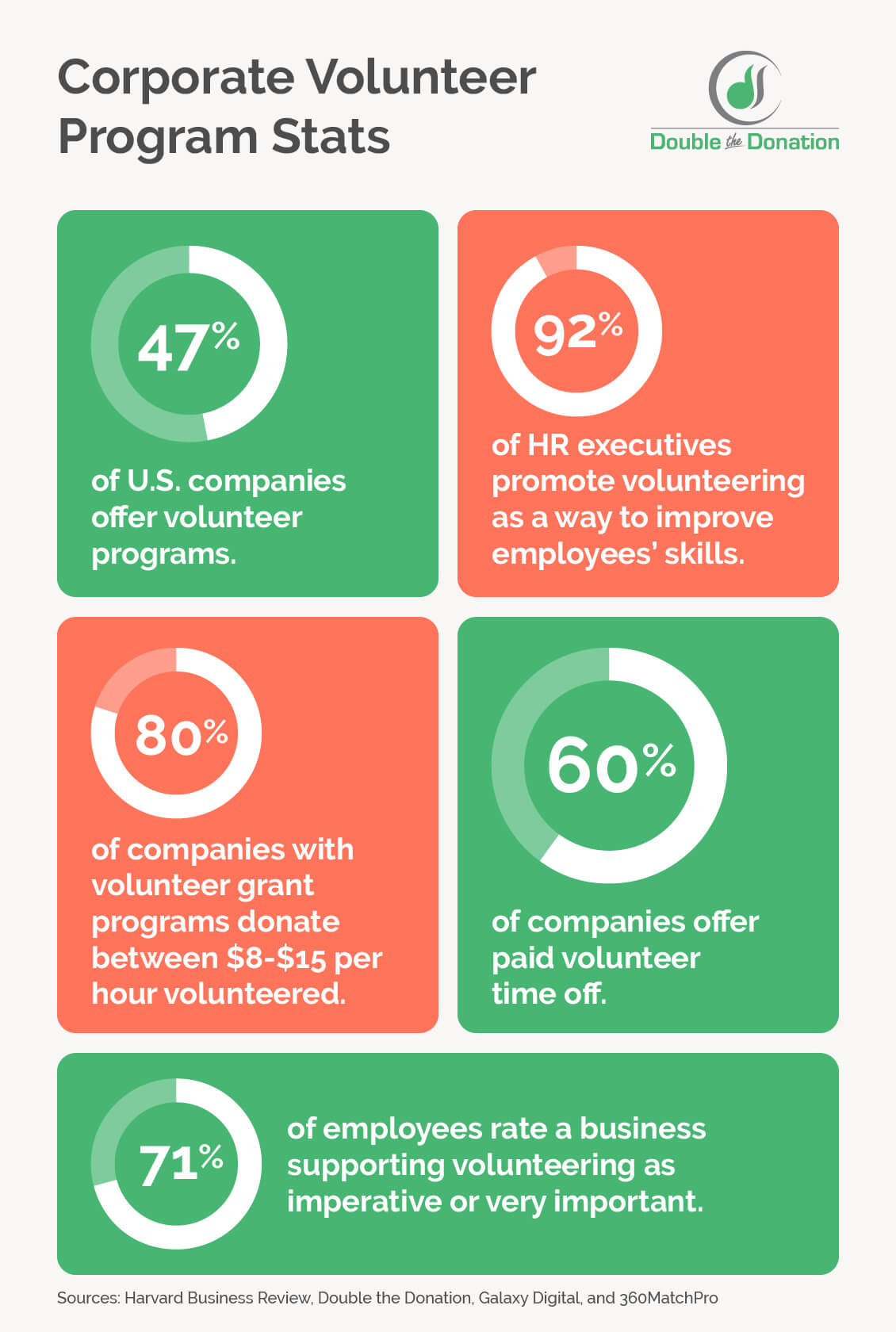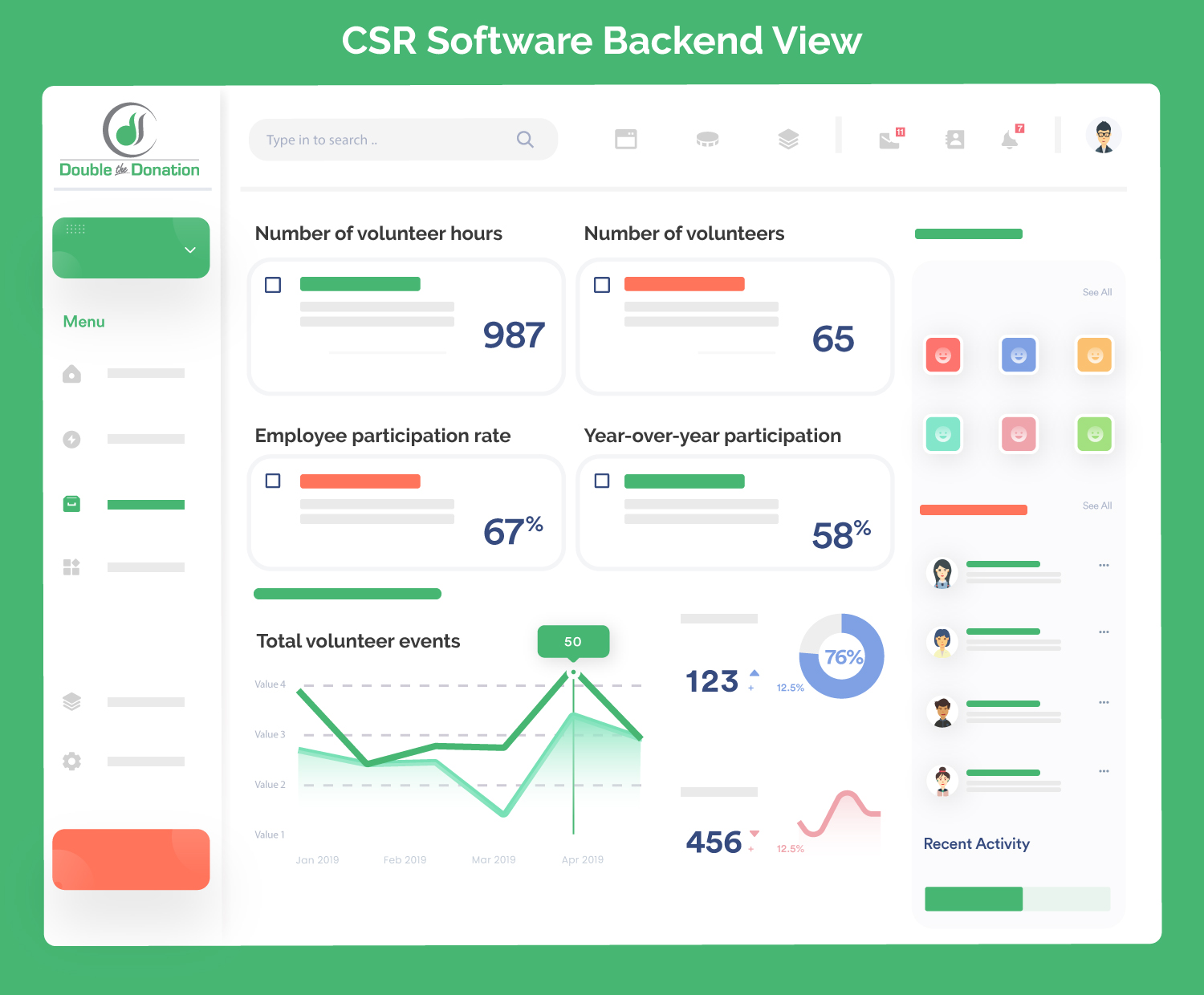Corporate Volunteer Programs: 7 Key Questions Answered
Corporate social responsibility (CSR) is a hot topic in the business world, especially when it comes to engaging employees. There’s a growing sentiment among the Millennial and Gen Z workforce that employers should provide ways for employees to give back, and the research supports this, with companies seeing a 52% reduction in turnover for new employees who participate in CSR initiatives, like corporate volunteer programs.
Among CSR programs, corporate volunteerism stands out since it enables employees to take a hands-on approach to giving back. However, volunteer initiatives fall short in number when compared to other employee giving programs, like matching gifts and donation drives.
These other initiatives are certainly helpful and often run themselves, but your business shouldn’t hesitate to offer a volunteer program. To help your business go the extra mile and provide a program your employees will love, we’ll provide a crash course on corporate volunteerism by answering seven burning questions business leaders commonly have about these programs.
Let’s get started.
1. What are corporate volunteer programs?
Part of the reason why businesses tend to have questions about corporate volunteer programs is because there are so many of them. Just like there’s a wide range of corporate philanthropy and CSR initiatives your business can invest in, there are many ways to host an employee volunteer program.
To provide a straightforward definition, corporate volunteer programs are volunteer initiatives for a business’s employees that the business arranges or supports. For instance, three popular types of volunteer programs include:
- Corporate volunteer days. Partner with a nonprofit in your area to arrange a day for your team to volunteer together. This might involve planting a community garden, helping pick up trash during a beach clean-up, sorting through donations for a homeless shelter, or any other activity a team can do.
- Volunteer time off. Add additional days specifically for volunteering to your employee’s paid time off plans. Volunteer time off allows employees to volunteer during work hours without worrying about missing a paycheck. This program can be especially effective for businesses that want to provide employees with flexibility in choosing what nonprofits they volunteer for.
- Volunteer grants. Also known as a Dollars for Doers program, volunteer grants encourage employee volunteering by providing monetary support to the nonprofits employees donate their time to. Businesses usually base their volunteer grant contributions on a per-hour basis or after a certain number of hours have been volunteered with a nonprofit. For instance, you might donate $10 to a nonprofit every hour an employee volunteers, or you might make a flat donation of $100 after an employee volunteers for 20 hours.
When choosing what volunteer program to offer, consider your CSR and employee engagement goals. If you want to support the causes your employees care about, offer volunteer grants. To encourage more volunteering and community involvement in general, consider offering volunteer time off. Or, build teamwork and camaraderie by hosting a team volunteer day.
2. What are the benefits of a corporate volunteer program?
Employee volunteer programs are an investment, whether it’s of your employees’ time or profits spent on volunteer grants. As with any program, business leaders must weigh whether the benefits make up for the resources that will be expended.
For corporate volunteer programs, the primary two benefits are:
- Engaged employees. CSR is about impacting your community, partly to prove that your business is committed to social and environmental good. Volunteer programs allow employees to be a part of your impact, making them feel like they personally are making a difference. When employees feel their work has meaning, their engagement, loyalty, and productivity all increase.
- Improved reputation. Businesses with reputations for supporting their communities will likely be supported in return. Volunteer programs allow you to build connections with nonprofits, linking their work to your business and gaining access to their support base.
To access these benefits, your business needs to promote its employee volunteer program. Employees and customers alike will only appreciate your corporate volunteer program if they’re aware of it.
Feature details about your volunteer program in key places related to your CSR initiatives, like your employee handbook, CSR employee software portal, and website.
For customers and other third parties share what your volunteer efforts have accomplished on your website. For instance, you might have a CSR or “Impact” page that discusses your CSR goals and ongoing programs. Highlight how many hours employees have volunteered, how much you’ve given through volunteer grants, or even just one successful volunteer day you organized.
3. What nonprofits should my company partner with?
As part of your corporate volunteer program, you will likely work with specific nonprofits. This might be organizations you arrange formal volunteer days with or nonprofits you promote to your employees to volunteer at on their own.
There is a wide range of worthy causes out there, and no business has the capacity to support all of them. Make you choose organizations that will benefit your business and you can make an impact at by taking the following steps:
- Consider your philanthropic mission. As part of establishing your CSR program, your business should form a philanthropic mission. This mission statement is usually broad— such as promoting sustainability or seeking to empower future generations—and will apply to several programs. When considering nonprofits to partner with formally, ensure their missions align with yours. For instance, if you’re committed to supporting education, partner with a nonprofit that provides free school supplies rather than one dedicated to mental health awareness.
- Interview employees. Your employees are the ones who will be volunteering, so make sure you pick causes they will be motivated to give their best effort to. Ask what causes or even specific organizations they want to see your business support. Additionally, discuss what skills employees can provide nonprofits. This can create extra valuable volunteer experiences where nonprofits receive professional help, and your employees can expand their skill sets.
- Research trusted organizations. When partnering with a nonprofit, you link their reputation to yours. Ensure you work with reputable organizations that produce real results you can share with employees and customers. Look at each nonprofit’s impact reports and use online tools like Candid and Charity Navigator to conduct background checks.
Outside of corporate volunteer programs, businesses should still follow these steps for other types of nonprofit partnerships, such as choosing what types of organizations are eligible for your matching gift program.
4. How widespread are corporate volunteer programs?
When launching a corporate volunteer program, know you’re not alone. Employee volunteer programs are rising in popularity among businesses of all sizes.
For a more specific breakdown of these programs’ popularity, let’s take a look at the research:
- 47% of U.S. companies offer volunteer programs. This includes all types of volunteer programs and companies with multiple programs, such as providing both volunteer time and volunteer grants.
- 92% of HR executives promote volunteering as a way to improve employees’ skills. Volunteering gives both employees and job candidates experiences working in new environments and learning new skills, including both soft skills like communication and hard skills like using bookkeeping and Google Suite expertise.
- 80% of companies with volunteer grant programs donate between $8-$15 per hour volunteered. If you’re not sure how to offer a budget-friendly volunteer grant program that’s still worth employees’ time, try looking at businesses similar to yours. Organizations of similar size and in similar fields can be a useful benchmark for keeping your CSR programs and benefits competitive.
- 60% of companies offer paid volunteer time off. This number is also only rising an additional 21% plan to implement a volunteer time off program sometime in 2024.
- 71% of employees rate a business supporting volunteering as imperative or very important.
This research emphasizes the importance of offering a volunteer program and ensuring your business’s culture supports employee participation. These things may seem like they go hand-in-hand, but at large corporations, it’s common for leadership to support the idea of volunteerism but middle managers to hesitate to approve volunteer time off requests and other volunteer initiatives.
If you have concerns about your business encountering problems like this, make plans to address it, such as stressing the importance of supporting your employee volunteer program at all-hands meetings or providing bonuses for participating. This might be a gift as simple as a company t-shirt, an appreciation eCard, or a more public award such as taking the department with the most accumulative volunteer hours out to lunch.
5. What tools does my company need to run an employee volunteer program?
Corporate volunteer programs are easier to manage when software does the heavy lifting for administrative tasks. To run your employee volunteer program or any other type of workplace giving initiative, you need CSR software.
Look for CSR software with features that support corporate volunteerism, such as the ability to:
- Record volunteer hours. Hour tracking is relatively straightforward, but software is necessary to document each employee’s volunteer hours over multiple years. Choose a platform with a user-friendly interface that allows employees to easily report their volunteer hours and provide the nonprofits’ information.
- Connect employees with nonprofits. If you want to encourage employees to volunteer on their own, choose a volunteer platform that lets you connect employees with volunteer opportunities. Some CSR software solutions will list reputable nonprofits the CSR platform vendor works with, while others allow you to promote specific organizations.
- Generate reports. Reporting capabilities are essential for ensuring your volunteer program produces results. Monitor how many employees volunteer, how many hours they volunteer, and which nonprofits they volunteer with. Then, create reports you can share with relevant stakeholders to demonstrate your corporate volunteer program’s value.
When investing in a CSR platform, consider what other CSR initiatives you’re interested in launching. For example, if you also want to host a matching gift program, consider a CSR vendor that enables matching gift auto-submission, an innovative feature that massively streamlines the matching gift application process.
6. How can my business increase participation in my volunteer program?
Why should an employee volunteer through your business rather than volunteering on their own? Does your program entice employees who don’t regularly volunteer to change their minds? How can I sustain participation in my volunteer program long-term?
These are the types of questions you should ask yourself to make your program appealing to employees and increase participation. While everyone volunteers for different reasons, three ways you can get employees involved include:
- Work with causes your employees care about. Employees will be more motivated to volunteer if their support goes to a cause they feel strongly about. For instance, you might limit what types of organizations are eligible for a volunteer grant to focus your philanthropic efforts. However, limiting flexibility also limits participation as employees may not volunteer if the causes they want to support won’t benefit.
- Make participating easy. There’s only so much time in the week, and employees may lack the energy or time to volunteer. Help connect employees with volunteer opportunities that fit their schedule, like online positions or roles with low-hour commitments.
- Promote your volunteer program regularly. After your initial program launch, maintain momentum by continually promoting it to employees. This might take the form of email reminders, recognition for those participating in all-hands meetings, or regular formally organized volunteer days.
Ultimately, the best way to get employees involved depends on your business. Talk to employees to understand how they feel about volunteering, how they want to volunteer, and what you can do to support them.
7. What are some examples of employee volunteer programs?
Corporate volunteer programs come in all shapes and sizes, so let’s explore some aspirational examples of real-world employee volunteer programs. These examples are from larger companies, but it’s possible for your business, no matter its size, to create similar initiatives at your own scale.
Salesforce
Software giant Salesforce encourages employees to volunteer by creating a milestone system. Each employee is given seven days of volunteer time off each year and is challenged to complete various goals related to volunteering, such as:
- Repeated volunteering with the same organization
- Organizing a team volunteer event
- Joining a nonprofit board
While not every employee will hit these milestones, those who do get entered into a lottery where the winner receives a grant for the nonprofit of their choice. Since the program’s inception, over 13,000 employees have been entered into this lottery.
Focusing on volunteering has also led Salesforce to form new nonprofit partnerships. For instance, Salesforce leadership noticed many employees volunteering with The Marcy Lab School, a nonprofit that provides high school graduates with job training to become software engineers.
This connection built a relationship between Salesforce and The Marcy Lab School, resulting in a $100,000 donation to The March Lab School through Salesforce’s grant program for emerging nonprofits. The prior years of employee volunteering helped Salesforce learn about the Marcy Lab School and build trust in their organization.
Microsoft
Microsoft is an international technology company that needs little introduction. However, their generous volunteer grant program is likely less known.
Microsoft launched their volunteer grant program in 2005, promising to donate $25 per hour employees volunteered. With almost 5,000 employees volunteering 430,000+ cumulative hours, Microsoft has donated over $10 million to nonprofits through their grant program alone in just one fiscal year.
Henkel
Henkel is a parent company that owns several brands related to cleaning products and adhesive technology. Across their brands, Henkel has instituted the Make an Impact Tomorrow (MIT) program. This initiative has been running for over 20 years, funding the volunteer efforts of both current and former Henkel employees.
In 2022 alone, MIT supported 80 charitable organizations, serving over 110,000 beneficiaries. These organizations included nonprofits such as the Special Olympics, Habitat for Humanity, and Feeding America.
Corporate Volunteer Programs: More Resources
Is a corporate volunteer program right for your business? If so, your next steps are to assess your corporate philanthropic goals, talk with your team, and invest in the right tools. Explore CSR software options and how they can elevate your future program.
Of course, another important step is to continue learning about and getting inspired by corporate volunteerism. Jumpstart your research with these resources:
- 8 Trends in Corporate Philanthropy for 2024: How to Tap In. Discover the future of corporate philanthropy and how your volunteer program fits into it.
- 23+ Corporate Volunteer Ideas to Build A Better Community. Not sure what type of volunteer program to launch? Get inspired with these volunteer ideas for businesses.
- Best Corporate Volunteering Platforms: Features to Look For. Jumpstart your corporate volunteer program with the right software solution! Start your research by discovering the top features you’ll need in your volunteer platform.







